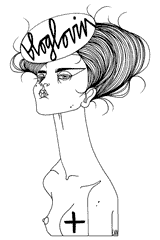Big moments in life are often affected by the little thoughts. Thoughts matter. Here are 4 articles that are thinking different about thinking.
The opportunities we seize, the solutions we find, and the risks we take are determined by what we notice versus what we don’t. Thoughts matter. Whether it’s inner speak or wild rhetoric, our thoughts and ideologies around thinking itself help us find freedom to express our dreams, doubts to constrict ourselves, solidarity within social circles, or violent discord and pitiful imbroglios within institutions. Legendary musician Sun Ra once stated, “Free your mind and your ass will follow.” Yet, even freeing the mind requires a level of discipline and constant study of what we believe we already know. Can better thoughts equal better communication? Here’s a curated list of 4 articles that are thinking different about thinking.
Evolution Prioritizes Surviving Over Thriving
Anxiety seems like a constant battle, but perhaps it’s not trying to be the enemy. This piece from The Conversation asserts that, “As it turns out, humans are wired to worry. Our brains are continually imagining futures that will meet our needs and things that could stand in the way of them. And sometimes any of those needs may be in conflict with each other.” The post looks at how our background thinking helped us worry enough to survive and why practices to ease the mind, such as yoga and guided meditation, are necessary for balance.
Is Personality > IQ When It Comes To Success?
Smarty pants. Empty pockets. Research suggests that a high IQ might not have as much bearing on a (financially) successful life as a conscientious personality does. Science is still having a hard time quantifying luck, but a paper by economist James Heckman suggests that diligence, perseverance and self-discipline are key factors to one’s human potential.
The Case for Abstraction
For a long time, art was strictly Realism. Until it wasn’t. The 21st century embraces abstract art to the extent of practically taking it for granted, but its ubiquity shouldn’t dampen its powerful lessons in how to think about the visual and invisible world. This piece from PBS bulletpoints important figures from different abstract movements and their goal to express the ineffable. For instance, Kandinsky’s art focused on the spiritual realms of emotion and consciousness, which go unseen but might be able to be painted nonetheless. Such interpretation is its own form of Realism. He claimed his art was quote, “…what the spectator lives or feels while under the effect of the form and color combinations of the picture”. Sonia Delauney illustrated a book of poetry that merged abstraction and typography. You can grab the full transcript of the PBS video here.
Minds of Our Own… Maybe
It’s a weird world we live in. We’re trying to figure out interstellar existence yet we still don’t really know what the mind is. We don’t fully grasp how our interior lives work, what consciousness is, and how it makes us uniquely human, for whatever that means. This New Yorker article starts looking at scientific theory around consciousness and weighs it against what it’s actually like to be alive. It asks questions about the metaphors and vocabulary being used to discuss knowledge, wisdom and information while pondering how these phrases are shaping and constraining the debate.




